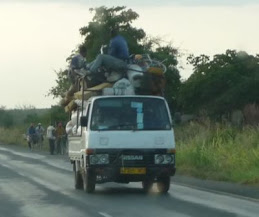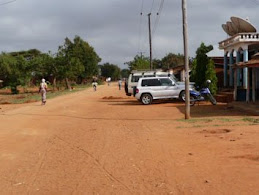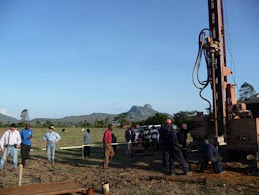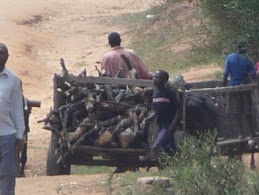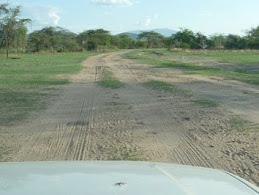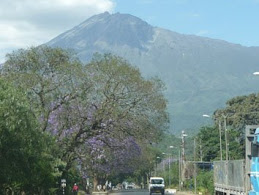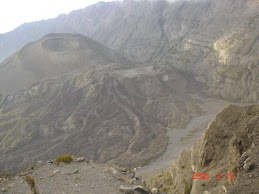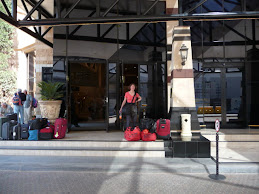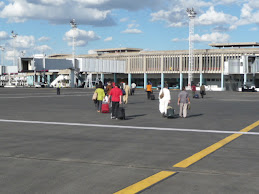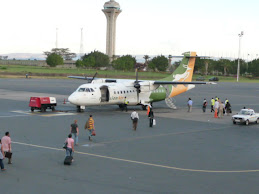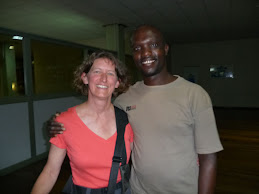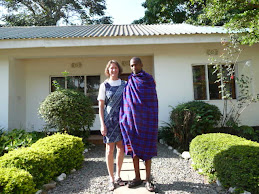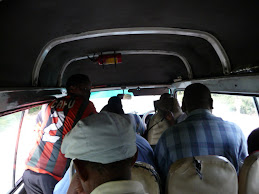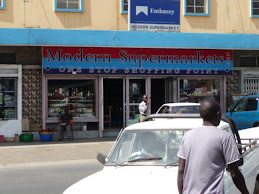This last weekend we went on a 4 day camping trip with other VSA volunteers, a German girl and a Danish guy. 9 of us all up. 3 people had been to this place before which was just as well as it is not obvious at all. The place is called Lake Natron in the NW of Tanzania. Not far from Ngorogoro Crater which is the big famous national park. To get to Natron however is 100 km (60 m) off the tarmac road. It took 5 hours to drive that distance. Corrugated gravel road that shakes you to bits, that then turns into a gravel dirt road, then a dirt road dropping down through dry river beds, or crossing high planes. Fun driving but our poor little truck gets a rough time on these roads. It managed them really well overall. There were 3 other vehicles as well so we travelled in sort of a convoy. Bruce has a 4WD high ace van he has fitted out for Africa and so includes a large tool box just as well. About ¼ of the way in the rubber bushing on the top of his front right shock disintegrated allowing the shock to bang around. He dives into his tool box comes out with a set of tools and an old piece of car tyre and makes a new bushing. This lasted about another 1 hour then the metal shims that hold the rubber bushing on became pounded out and they and the rubber came off again. Bruce makes a new rubber and I find a 3/8” washer at the bottom of his box. This is quite a bit thicker than the metal shims so he puts that on and it holds the rest of the weekend just fine.
Then a bit more on Alan and Andrea get a puncture in their Landrover. Now we are hours from anywhere, no chance of getting any repair of the tyre. We put the spare on and Alan says at the end up by the lake there is a tiny village maybe we can get another tube there. So off we go again fingers crossed.
At one point we drive through the crater highlands. This is a high grassy plane, with mountains on both sides, except that now it is so dry that there is only stalks left. But there are these small craters from old volcanoes all over the place. Very cool scenery, hostile to life but beautiful to admire. This is also the heart of Maasai country. The Maasai are cattle and goat herders. They wander around the planes and mountains with their herds looking for food for them. They live in Boma’s which is like a collection of ½ dozen igloos made of mud. In this area there is extremely little water. The Maasai have learned to live without much water, they drink things like animal blood. As we drove along the road, some that were close to the road and seeing 4 vehicles drive along, would come running down to the road begging for any water. Money was not important to them like it is in Arusha or more normal places. They just wanted water. Quite a shock to the mind to see and learn this. The Maasai dress in the most beautiful colours. The men are wrapped in a tartan like red/black cloth and they all carry a spear or stick. The women are similar but wear all this ornate jewellery. Large earrings, multiple in each ear, intricate neck pieces. Very stunning to look at them. They have their own language too so we could not understand anything they said only when they indicted drinking something.
Also at this Lake Natron is Ol Doinyo Lengai Volcano. This is Maasai for Mountain of God. As we drove north we saw the mountain come into view. It is a very symmetric steep mountain all by itself about a mile from any other mountains. We had to drive past it to get to the lake and the camp ground. It is still an active volcano, last erupted in 2006 with a large amount of rocks and ash and sand. (No Lava). You could see from its slopes there were no trees or plants, just rock sheets and rocks and sand gullies that water had flowed down in. It is quite pretty really in an odd way.
We got to camp just at dusk and set up the tents, and found they had a swimming pool albeit a little green and they served cold beer and sodas. We were set.
They next day we spent a lot in the pool as the heat was impressive once out of the shade. Ramona walked off the grassy area that was the campground boundary out on to the edge of the lake bed (when the lake used to be that high, all just sand now) and wow was it hot out there. Back to the pool. There is a little town a km down the road that we were told may have a spare tube for Alan. The camp owner asked us while we were in town if we could bring his supplies back as he had just seen the bus go buy and he didn’t want them to sit around for too long. There would be a guide there too we could talk to he said about climbing the mountain. So off we went. Found a tube at an exorbitant price, but the vendor had us over a barrel. We bought that and went to find the guide and a cold coke in a little wooden shack. This was a Maasai town, about a dozen wooden buildings. The clothing was impressive all over, some women in the bright red with jewellery, some in black from a different tribe with different jewellery. Bruce bought a great Maasai spear for $15. There is no phones here, no TV, no news paper. This was their world and that was all they knew. But very friendly people. They were selling all sorts of trinkets and jewellery very cheap. We arranged for the guide to meet us at 11 pm that night. They days are too hot, especially climbing on black rocks and sand, to climb during the day. So we were to do a night climb.
At about 5 pm we drove around to the lake bottom to a point where we could access the lake to see the Flamingos. The lake is low so there was about ½ mile of dry sandy mud to walk from the car stop point to the water’s edge. It is an alkaline lake too, so nothing grows, quite a stark arid area. Then there are these beautiful pink delicate big Flamingos by the 1000. Everywhere. A group here another over there etc. The horizon on the lake was just a pink band. Some were landing, some were taking off, others feeding or talking. The contrast of the aridness to the colourful birds was just so impressive.
We tied to get an hours sleep after dinner that night but not too successful. Got up at 11 and drove to the camp gate where the guide or actually the guide’s substitute was waiting for us. He said in broken English he was the guide’s brother and his brother was sick. Not good, the original guide was very experienced and spoke quite good English. Alan was saying this was a set up, to take our money and not do the climb. We talked with him some more and noted he had bought some climbing sticks with him for us to use which we took as a good sign, so we decided to take the risk. It was about 30 mins drive to the base of the mtn. Along the way we chatted some more to him in broken English and got to feel better about the situation as he seemed to know what he was talking about. He had bought a 2nd guy to stand security on the Landrover while we were climbing. We started climbing at midnight. It was a starry night, clear with a cool breeze blowing which made it a great night for a climb. We were walking on sandy trails or sandy rivulets in between sheets of rock from previous eruptions. The higher we got the more steep it became. The sand made climbing tiresome slipping backwards all the time. At 3:30 Ramona and Alan said they would stop there as it was getting more and more difficult to make progress. They nestled down behind a big rock out of the wind and waited for us to return. The guide made sure they understood to not move away from this area. He said it was too dangerous to attempt to walk down in the dark; we had to descend in daylight. Alan is quite an experienced climber which made me feel better about them stopping there by themselves. That left myself, Yong and the guide to go further on. At about 4:30 the going was steeper still and the sand and rough rock plates were making harder and harder to get a footing on. Yong said he was so tired that he just wanted to go to sleep, so he said he would stop there. It was still another 2.5 hours to the top the guide said. Poor Yong however was on a steep part and could find no flat space too lie down, so he sat down and propped himself up with his walking stick so he wouldn’t fall over when he fell asleep.
There were two other groups on the mtn too. They had started after us and had passed us earlier on so we could see their lights up the mtn. The guide and I carried on, we passed one group, then the second group as they had stopped for a rest. Once they started again they soon passed us. A fit Canadian couple with a guide. As we neared what looked to be the top rim there was a little bit of damp soil like stuff around and it made climbing on the rocks slippery. It was steep enough now that often I was climbing on all 4s to grab rocks and lift my feet up trying not to slip. Still a lot of soft sand in the gullies between the rock plates. By now I was rather tired. The sun had just come up so the head lamps could be turned off. Approaching the rim I could now see these two great rock structures like a gate way with a gap between them. We were heading for the gap. That must be the top I thought. However as we got within a 100 meters, I could see there was yet another ½ mile (1 km) more of rock and sand to go up beyond this gap. My heart sank; the 7 hours of exertion were taking their toll. That would take at least another hour or more. The guide was 10 m in front and once through the gap he turned left and disappeared from sight. I got to the gap a few minutes later and turned left too, to find a gentle ridge going up about 70 meters to where it turned to the right into the top ridge around the crater and that was quite flat. My joy soared we didn’t have to climb that ½ mile of sloping rock after all. It was now very easy walking on the rim. I could finally get the camera out and take some pictures. The top was a series of depressions and the main crater with a thin rim between them all. One side of the rim would fall down the mtn, the other side of the rim would fall into the crater or one of these other depressions. The rim was about 4 ft wide so it was quite safe and easy to walk along. The crater was about 1 km wide. On the inside the rim sloped steeply down for about 100 m then a sudden 100 m deep drop off down to the bottom of the crater. You could see steam, smell a bit of sulphur, and see rock that had cooled from lava extrusions. Pretty cool stuff.
The outside of the rim fell away steeply on all sides. With the sun just up and low on the horizon, the whole mtn cast a perfect symmetric shadow on the big escarpment cliff about a mile away. That made for a nice picture.
Then came the going down, not something I was looking forwards to. The Canadians had left to go down about 15 mins before us. The third group was still coming up. The rock plates were too slippery to walk on top of let alone try to step down on them, so it meant walking in the sand gullies between the rock plates. These gullies or rivulets were from 1 – 4 ft deep and 1- 4 ft wide. The sand was not slippery like the rocks but you could easily slide down with all the sand around your boot sliding down to. So the process was to take the walking stick, stick it in the sand or a crevice about 2 ft in front, then step down to the stick with one foot, if that held, then step down with the other foot while hanging on to a rock edge on the edge of the rock plate with the remaining hand. Then repeat over again. A slow but steady process. I knocked a few rocks loose and we had to yell out to the Canadians about 100 yds in front of us below to ‘Look Out’ as that can be very dangerous. Once going, those rolling & bouncing rocks do not stop for ages. The further down the less step it got and easier to walk.
It took about 4 hours to go down, picking up Yong then Ramona and Alan along the way. By then it was near 11 am and the heat was in full force. Needless to say the afternoon was spent in the pool in the shade with cold cokes and beers.
It took 4-1/2 hrs to drive out again the next day, passing Zebra, Ostrich, Jackals’, etc. This time we had filled up all our empty water bottles and handed them out to the Maasai people who came up to the road as we drove along. Some were so excited to get water.
About ½ way out, there was an ancient stone ruins site off the way so we went to that for a short diversion. About 500 yrs old, it was occupied by some people pre Maasai. People called Songo they thought, whose relatives now live way up north of Lake Natron. Not a lot of details known as there was no written language amongst those people pre-European.
Sunday, September 27, 2009
Lions in Ruaha National Park
After installing the last pump, we took a couple of days off to go further south to Iringa and to visit another big game park called Ruaha. The drive is through the Mikumi national park to Iringa and is on tarmac. Iringa town itself is off the main road about 2 km up on top of a cliff. The main street runs along parallel to the cliff top. We chatted to a guiding company about whether to use them to get to the park or whether to drive there our selves in our Pajero. We had heard the road was not so good from Iringa to the park. After considering the options we choose to book a night at a lodge just outside the park entrance and rent their guide and vehicle from there. That meant us driving the 60 km to the lodge. It was mostly flat but corrugated and rough. It took 3 hours to get there. We got there at dusk. The lodge was way up on the side of a hill with great views of the planes and trees below. At that time of year though, it was very very dry. No greenery to see, most things including trees are covered in dust. No chance of seeing any animals in the trees below as there is nothing for them to eat there.
The Lodge included a fixed evening meal that we shared with a group of Germans who had come too. They had a great wooden log balcony to sit on with a cold drink and look out over the tree covered land below and low mountains in the distant inside the park. I must have eaten something bad in Iringa as my stomach was quite upset and could not face a meal. Ramona was fine thankfully. I later lost what little was in my stomach too.
In the morning I saw the Land Cruiser out front ready to go. They guy was letting it roll down hill to jump start it. Hmm I thought. It was 30 km to the park entrance on the same road as yesterday. The Land Cruiser had a lift up top on it so customers can stand up in it and view game. While driving around though the top is normally down. Most of the rubber seals had worn out and it rattled so loud we really couldn’t talk. Once in the park we stopped at a bridge over a river to watch alligators, some hippos, some baboons leaping over rocks and little water ways, so cute. Not long after the bridge the driver stops and gets out of the vehicle, something had broken. We look under the rear and see the sway bar lying on the ground. Two mounts that are meant to hold it up had come undone, the bolts fallen out and lost. He ties it up with a bit of rubber tubing which looked dubious. On we go for about another 15 mins and the same thing happens. He ties it up again and adds a bit of thin wire this time. Then he drives to the head quarters a couple of miles further up the road and into their maintenance compound. He asks one of the mechanics there if they can fix it. About 1 hour later they have it repaired and we have to push start the vehicle again. So at a little after noon we finally begin our game drive proper. A little irritated by now. But the driver knows his stuff and we soon come across Jackals, umpteen Zebra, Giraffe, Warthogs, Impala, and then Ramona says this looks like a good spot for lions. Sure enough we see a lion under a tree, then another and another. 9 all told sitting there in the shade on a raised river bank overlooking the near dry river and the impala out there. We park about 20 ft ( 7 m) from and just below them in the river bed and watch them for ages. They could care less about us, sleeping and watch the impala was the order of the moment it seemed. Eventually one got up and walked down the bank and started to walk out to the river bed behind us intently staring at an impala. Then another and a 3rd. They were fanned out. A 4th one who had been on our front right got up and started to walk past us to join the others. I had been videoing her but as walked towards us she filled the lens. I was backing off the zoom to keep her in the lens then realised there was no more backing off to do as she was just off to the side of the truck walking past us. Ramona was so excited to see this massive cat just right there walking past us. The lion joined the others now in a spread out pattern that looked like a military plan. They sat there so still and just watched that impala. Magnificent, such patience and stealth.
We drove off to leave them in peace. Stopped for lunch well away from the lions. Some others were there and said they had seen a cheetah not far away. So off we went in search of that. The driver found her quite soon stretched out on the ground under a big Baobab tree in the shade. Compared to the big muscled lions, the cheetah is very thin and wiry, built for speed. A movement under the tree caught our eye and out walked a little cub then another. So cute! They walk up to their mama then start playing with each other for a bit. They are very thin too. The mother spots an impala about 200 m away and gets up slowly and she too stealthily walks towards the impala. Seems like Impala was on the menu that day. The cubs follow off too after their mama. She disappears low in the brown grass and we loose sight of her and the cubs. But what a treat to see nature in action.
We head back as it is getting late. Along the way we come across a group of elephants, then a big group of water buffalo under some trees in the shade. Out of the park and almost back at the lodge we get a puncture. The driver rummages around and comes out with a little bottle jack and wrench. We take the flat type off and can’t put the new one on as the jack won’t lift the axel up high enough. I tell the driver we’ll have to dig down to make a depression in the road to put the tyre in low enough to get in on the studs. We do this and get the wheel on. But the truck engine has stopped and now the truck has one wheel in a hole so we can’t push it out with just the three of us. Fortunately just then a van comes driving by and he pushes the land cruiser to get it started and we get back to the lodge at about 4 pm. We say good bye to the staff there, told them their vehicle needs some good maintenance and jump in our Pajero and start the 3 hr drive back to Iringa, knowing that the last hour will be in darkness. Not recommended. But it all went ok.
The next day we went to the Isimila Stone Age site not far from Iringa. This is the site of some very old discoveries of some of the earliest humans. 2nd to the Olduvai gorge only where the Leakeys found their famous finds in the late 50’s. So quite an important site. Not that you would know by the way it was presented. A small confusing sign on the side of the road, then a windy track through some back yards of mud houses down to an over look site that at least did have some respectable buildings on it. There was no one around so we walked down the part to the bottom of the gorge even though it said not too. Once at the bottom, a guide saw us from the top and came running down to show us around. Basically a very dry sand and stony river bed with some old excavators huts on it. The area had not been excavated since the 50’s too. The guide took us on an excursion over to another nearby canyon that we could not see at all from up top. It had some spectacular rock towers in it about 10 m high, we were able to walk right in down amongst them. Fascinating to see structures like this.
After Isimila we headed back to Mikumi. The hills along the Iringa to Mikumi gorge are quite steep with a river at the bottom most of the way. Being steep they have not been grazed or cultivated hence they are still covered in bush. In addition to the usual wrecked trucks along the road, from punctures, to broken axels, to being tipped over, there were forest fires everywhere, not large ones, but smoke and flames were quite common. Some along the road side as the picture shows. This was a first for us to drive past fires like this. There were no fire men or anyone in attendance at any of these fires. They just burn themselves out eventually we concluded. Tanzania continues to be an adventure. Then it was back to Gairo.
The Lodge included a fixed evening meal that we shared with a group of Germans who had come too. They had a great wooden log balcony to sit on with a cold drink and look out over the tree covered land below and low mountains in the distant inside the park. I must have eaten something bad in Iringa as my stomach was quite upset and could not face a meal. Ramona was fine thankfully. I later lost what little was in my stomach too.
In the morning I saw the Land Cruiser out front ready to go. They guy was letting it roll down hill to jump start it. Hmm I thought. It was 30 km to the park entrance on the same road as yesterday. The Land Cruiser had a lift up top on it so customers can stand up in it and view game. While driving around though the top is normally down. Most of the rubber seals had worn out and it rattled so loud we really couldn’t talk. Once in the park we stopped at a bridge over a river to watch alligators, some hippos, some baboons leaping over rocks and little water ways, so cute. Not long after the bridge the driver stops and gets out of the vehicle, something had broken. We look under the rear and see the sway bar lying on the ground. Two mounts that are meant to hold it up had come undone, the bolts fallen out and lost. He ties it up with a bit of rubber tubing which looked dubious. On we go for about another 15 mins and the same thing happens. He ties it up again and adds a bit of thin wire this time. Then he drives to the head quarters a couple of miles further up the road and into their maintenance compound. He asks one of the mechanics there if they can fix it. About 1 hour later they have it repaired and we have to push start the vehicle again. So at a little after noon we finally begin our game drive proper. A little irritated by now. But the driver knows his stuff and we soon come across Jackals, umpteen Zebra, Giraffe, Warthogs, Impala, and then Ramona says this looks like a good spot for lions. Sure enough we see a lion under a tree, then another and another. 9 all told sitting there in the shade on a raised river bank overlooking the near dry river and the impala out there. We park about 20 ft ( 7 m) from and just below them in the river bed and watch them for ages. They could care less about us, sleeping and watch the impala was the order of the moment it seemed. Eventually one got up and walked down the bank and started to walk out to the river bed behind us intently staring at an impala. Then another and a 3rd. They were fanned out. A 4th one who had been on our front right got up and started to walk past us to join the others. I had been videoing her but as walked towards us she filled the lens. I was backing off the zoom to keep her in the lens then realised there was no more backing off to do as she was just off to the side of the truck walking past us. Ramona was so excited to see this massive cat just right there walking past us. The lion joined the others now in a spread out pattern that looked like a military plan. They sat there so still and just watched that impala. Magnificent, such patience and stealth.
We drove off to leave them in peace. Stopped for lunch well away from the lions. Some others were there and said they had seen a cheetah not far away. So off we went in search of that. The driver found her quite soon stretched out on the ground under a big Baobab tree in the shade. Compared to the big muscled lions, the cheetah is very thin and wiry, built for speed. A movement under the tree caught our eye and out walked a little cub then another. So cute! They walk up to their mama then start playing with each other for a bit. They are very thin too. The mother spots an impala about 200 m away and gets up slowly and she too stealthily walks towards the impala. Seems like Impala was on the menu that day. The cubs follow off too after their mama. She disappears low in the brown grass and we loose sight of her and the cubs. But what a treat to see nature in action.
We head back as it is getting late. Along the way we come across a group of elephants, then a big group of water buffalo under some trees in the shade. Out of the park and almost back at the lodge we get a puncture. The driver rummages around and comes out with a little bottle jack and wrench. We take the flat type off and can’t put the new one on as the jack won’t lift the axel up high enough. I tell the driver we’ll have to dig down to make a depression in the road to put the tyre in low enough to get in on the studs. We do this and get the wheel on. But the truck engine has stopped and now the truck has one wheel in a hole so we can’t push it out with just the three of us. Fortunately just then a van comes driving by and he pushes the land cruiser to get it started and we get back to the lodge at about 4 pm. We say good bye to the staff there, told them their vehicle needs some good maintenance and jump in our Pajero and start the 3 hr drive back to Iringa, knowing that the last hour will be in darkness. Not recommended. But it all went ok.
The next day we went to the Isimila Stone Age site not far from Iringa. This is the site of some very old discoveries of some of the earliest humans. 2nd to the Olduvai gorge only where the Leakeys found their famous finds in the late 50’s. So quite an important site. Not that you would know by the way it was presented. A small confusing sign on the side of the road, then a windy track through some back yards of mud houses down to an over look site that at least did have some respectable buildings on it. There was no one around so we walked down the part to the bottom of the gorge even though it said not too. Once at the bottom, a guide saw us from the top and came running down to show us around. Basically a very dry sand and stony river bed with some old excavators huts on it. The area had not been excavated since the 50’s too. The guide took us on an excursion over to another nearby canyon that we could not see at all from up top. It had some spectacular rock towers in it about 10 m high, we were able to walk right in down amongst them. Fascinating to see structures like this.
After Isimila we headed back to Mikumi. The hills along the Iringa to Mikumi gorge are quite steep with a river at the bottom most of the way. Being steep they have not been grazed or cultivated hence they are still covered in bush. In addition to the usual wrecked trucks along the road, from punctures, to broken axels, to being tipped over, there were forest fires everywhere, not large ones, but smoke and flames were quite common. Some along the road side as the picture shows. This was a first for us to drive past fires like this. There were no fire men or anyone in attendance at any of these fires. They just burn themselves out eventually we concluded. Tanzania continues to be an adventure. Then it was back to Gairo.
Wednesday, September 23, 2009
From 4 hours to 5 Minutes
The day we left Gairo Musa from the VSA office in Arusha came down to see our work and to collect some items VSA had provided for the house we had been staying in. We took him on a tour of 15 wells. Musa was able to talk to the local villagers very well. One woman came up to talk to him as she could not talk to us with our limited Swahili. She was telling him how thankful they were to get this water. This particular village had no other water source and they had to walk many kms or 4 or so hours sometimes to get 20 liters of water. Now they have water a 5 min walk from their house. It is not an unlimited amount of water and they have to pump somewhat hard to lift water from that depth, but at least it is some water for them. That is what we came for.
Pumps are Installed
In Mid August Ramona and I drove our truck back down to Gairo to finish the installation work for the 17 pumps. We spent 2 nights in Dar es Salam where we picked up some of the Tanira manufactured pump parts we would need in Gairo, caught up with some friends and bought 3 weeks’ worth of groceries from one of the big new grocery stores in Dar. There is not too much available in Gairo for Mzungus.
After leavingDar we headed to Morogoro to pick up the remainder of the SWN pump parts we also needed, and then arrived at Gairo 2 hours later.
We had bought down to the Gairo office the laptop computer that had been back at Adra for a couple of weeks while we reset the settings back up for it operate correctly. The first day in Gairo we spent in the office instructing the staff how to use the computer, how to connect to the internet, send emails and check emails, put attachments on emails, sending pictures, and how to open and close the usual Office documents.
Over the next two weeks we installed all the pumps, generally 2-3 per day depending on how deep the pump inlet was set at. Due to Ross’ should injury and not able to lift anything heavy, the Project manager had arranged for a 2nd fundi to help us out with the installations. Nick was the one we had planned to us, but now we had Nick and Jonas. They were great to work with, learned fast, and were keen to work longer hours as required. It worked out best having Jonas there as well as now there are two people in Gairo who know in detail how to install these pumps, how to remove and repair them. The pumps are spread over 6 small villages around Gairo town. Nick and Jonas got to know the Village officers well while we were doing the installations so they have a good relationship set up now for the villagers to contact Nick if the pumps breakdown and need a service. So we think we have set up a very sustainable water supply. A typical installation would involve Nick Supervising, and doing the critical rod assemblies, Jonas doing the backup preparation and then up to 8 or so village males of various ages helping with the lifting of the rods to lower down the well, then about 20 or more other people watching and offering unendless suggestions. Often during the installations the people would be chatting back and forth with Nick and Jonas making jokes, some about us we gather, or singing a song (because they were happy they said at that time). This part of the project was the most rewarding. A very satisfying feeling that we were giving something to these people who basically have nothing and that the benefits to them were so obvious and to see how happy they were was truly a moving experience.
When we finished installing a pump, Nick or one of the village elders would get on the handle first and do the first pump strokes. We would take a picture of the first water coming out of that well. It would take a few strokes to get the water all the way up to the top, then it would start gushing out the outlet spigot. Clear cool water stroke after stroke. The mamas quickly appeared on the scene with their plastic buckets for filling. In some cases there were dozens of them with buckets awaiting water.
One of the wells was in Gairo town itself right outside our house we were staying in along one of the main back streets. We installed this pump early on as we wanted to be able to watch its use all the while we were there. Ironically enough as Gairo is a much bigger town than a small outlying village, we would have a lot of people to stop by and watch but no officials to come around and organise the local people. It is a shallow installation of 30 m, so it did not take long to install. Some of the neighbouring kids we had made good friends with back in Jan-Mar were there and they helped where they could. They are a lot of fun too. Once the pump was pumping water, the people seemed to come from every house we could see to get water. In Gairo, the water is normally a gravity fed system from up in the distant mountains. It is only turned on every 3rd day however as it is shared with other towns too. Water from this source is charged at 20 shillings (2 cents)per 20 liter bucket. But with this pump on their main back street, providing water at any time and it was free, this was a big deal for them. That poor pump was pumped from dawn to dusk every day by mamas or children. It seemed they were doing a pump stroke about every second, over 12 hours that is a lot of strokes. The pump is really designed to be used by a taller somewhat strong person that can do full strokes of the handle getting maximum water per stroke. However a lot of the women are shorter as are the kids and they would not have the arm strength to do full pump strokes time after time. Instead they would pull the handle down then lean over it with stiff arms and then bounce up and down on their feet (as their legs are stronger than their arms) to jiggle the handle up and down about 10% of its stroke. They can keep this up for ages albeit at a low water flow rate. We’d go out there time and time again to show them how to do full strokes to get full water flow and try to tell them it was better for the pump to do long slow strokes rather than these short rapid strokes. They would listen for a few minutes then 10 mins later you could come back and a new set of mamas or kids were on it doing the jiggle again. There were just too many different users over a full day to try to tell them all how to do it properly. After 2 days the Gairo pump stopped pumping water so we had to pull it out to see the problem. We could tell it was not working when we drove up to it as there were no people around using it. This was a very good learning exercise for Nick and Jonas. They were able pull the pump out and investigate where the problem was without Ross showing them where to look for the problem. The bottom cylinder internal plunger had unscrewed there by letting water back out the bottom again. We screwed it back together again tight with a big pipe wrench and reinstalled the pump. It worked well again and all the people came back with their buckets. 2 days later the same thing happened. Nick wanted to leave it not working for a few days to teach the people a lesson that they need to not do the jiggle stroke as that probably helped the bottom valve to unscrew. After we did pull the pump again and take the bottom cylinder apart and saw the same valve had come unscrewed I explained to Nick and Jonas there was a liquid called LockTite that was designed to keep threads from coming unscrewed. We had to search almost every hardware type store in Gairo but eventually found an equivalent product. We reassembled the valve and let it dry a day before reinserting the pump in the well. For the next 2 weeks after, till we left, the pump worked perfectly.
The SWN pumps had 4 m long rods that are made up of an outer PVC pipe 1-1/2” in diameter and a 3/8” diameter inner stainless steel suction rod. We noticed that over a 4 m section, the PVC was 10 mm longer than the steel rod. Hence over a 50 m length of assembled rods there was a 120 mm difference in the inner steel rods compared to the outer PVC pipe. This caused a problem and would not let the pump piston in the bottom cylinder have full travel. It didn’t matter on the shallower pumps but on these 50 m deep installations it was a problem. There were 4 of them too. We contacted the supplier in Morogoro and asked them to make up 4 short rods 100 mm long. When we added these short steel rods to the stack up of the 4 m long steel rods, that extra length let the pumps work properly giving full flow per stroke.
These 4 deep (50 m +) SWN pumps also had special bottom valves to allow then to pump from greater depths. After we had finished installing the deepest one at 57.5 m deep, when tested, even though the pump pumped water the action just felt wrong. Ross explained to Nick that we would have to pull the pump out to see what the problem was. We arranged to do this in a couple of days time as we knew it would be tricky. By now the 57.5 m of rods were also full of water and the whole set up was very heavy, 200 kg approx. We had to devise a slow and safe way to be able to lift these out using a lot of people to help lift. The problem was a manufacturing flaw. One of the steel fittings in the bottom valve had a bit of casting slag still in it that the valve was catching on. This was preventing the valve from moving up and down. We filed it off and the pump worked fine after that. It had taken 8 hours to pull the pump out, find the problem and repair it and then reassemble it back in the well again. Another good practice session for Nick and Jonas to learn from.
After we had finished the pump work, and the day before we left, the ADRA crew in Gairo had a little farewell meeting for us to say thank you for coming down to help them with their project and for getting to know each other. They presented us with some local gifts. A Kitanga for Ramona and a Maasai wrap for Ross. This was such a great moment to share with them.
After leavingDar we headed to Morogoro to pick up the remainder of the SWN pump parts we also needed, and then arrived at Gairo 2 hours later.
We had bought down to the Gairo office the laptop computer that had been back at Adra for a couple of weeks while we reset the settings back up for it operate correctly. The first day in Gairo we spent in the office instructing the staff how to use the computer, how to connect to the internet, send emails and check emails, put attachments on emails, sending pictures, and how to open and close the usual Office documents.
Over the next two weeks we installed all the pumps, generally 2-3 per day depending on how deep the pump inlet was set at. Due to Ross’ should injury and not able to lift anything heavy, the Project manager had arranged for a 2nd fundi to help us out with the installations. Nick was the one we had planned to us, but now we had Nick and Jonas. They were great to work with, learned fast, and were keen to work longer hours as required. It worked out best having Jonas there as well as now there are two people in Gairo who know in detail how to install these pumps, how to remove and repair them. The pumps are spread over 6 small villages around Gairo town. Nick and Jonas got to know the Village officers well while we were doing the installations so they have a good relationship set up now for the villagers to contact Nick if the pumps breakdown and need a service. So we think we have set up a very sustainable water supply. A typical installation would involve Nick Supervising, and doing the critical rod assemblies, Jonas doing the backup preparation and then up to 8 or so village males of various ages helping with the lifting of the rods to lower down the well, then about 20 or more other people watching and offering unendless suggestions. Often during the installations the people would be chatting back and forth with Nick and Jonas making jokes, some about us we gather, or singing a song (because they were happy they said at that time). This part of the project was the most rewarding. A very satisfying feeling that we were giving something to these people who basically have nothing and that the benefits to them were so obvious and to see how happy they were was truly a moving experience.
When we finished installing a pump, Nick or one of the village elders would get on the handle first and do the first pump strokes. We would take a picture of the first water coming out of that well. It would take a few strokes to get the water all the way up to the top, then it would start gushing out the outlet spigot. Clear cool water stroke after stroke. The mamas quickly appeared on the scene with their plastic buckets for filling. In some cases there were dozens of them with buckets awaiting water.
One of the wells was in Gairo town itself right outside our house we were staying in along one of the main back streets. We installed this pump early on as we wanted to be able to watch its use all the while we were there. Ironically enough as Gairo is a much bigger town than a small outlying village, we would have a lot of people to stop by and watch but no officials to come around and organise the local people. It is a shallow installation of 30 m, so it did not take long to install. Some of the neighbouring kids we had made good friends with back in Jan-Mar were there and they helped where they could. They are a lot of fun too. Once the pump was pumping water, the people seemed to come from every house we could see to get water. In Gairo, the water is normally a gravity fed system from up in the distant mountains. It is only turned on every 3rd day however as it is shared with other towns too. Water from this source is charged at 20 shillings (2 cents)per 20 liter bucket. But with this pump on their main back street, providing water at any time and it was free, this was a big deal for them. That poor pump was pumped from dawn to dusk every day by mamas or children. It seemed they were doing a pump stroke about every second, over 12 hours that is a lot of strokes. The pump is really designed to be used by a taller somewhat strong person that can do full strokes of the handle getting maximum water per stroke. However a lot of the women are shorter as are the kids and they would not have the arm strength to do full pump strokes time after time. Instead they would pull the handle down then lean over it with stiff arms and then bounce up and down on their feet (as their legs are stronger than their arms) to jiggle the handle up and down about 10% of its stroke. They can keep this up for ages albeit at a low water flow rate. We’d go out there time and time again to show them how to do full strokes to get full water flow and try to tell them it was better for the pump to do long slow strokes rather than these short rapid strokes. They would listen for a few minutes then 10 mins later you could come back and a new set of mamas or kids were on it doing the jiggle again. There were just too many different users over a full day to try to tell them all how to do it properly. After 2 days the Gairo pump stopped pumping water so we had to pull it out to see the problem. We could tell it was not working when we drove up to it as there were no people around using it. This was a very good learning exercise for Nick and Jonas. They were able pull the pump out and investigate where the problem was without Ross showing them where to look for the problem. The bottom cylinder internal plunger had unscrewed there by letting water back out the bottom again. We screwed it back together again tight with a big pipe wrench and reinstalled the pump. It worked well again and all the people came back with their buckets. 2 days later the same thing happened. Nick wanted to leave it not working for a few days to teach the people a lesson that they need to not do the jiggle stroke as that probably helped the bottom valve to unscrew. After we did pull the pump again and take the bottom cylinder apart and saw the same valve had come unscrewed I explained to Nick and Jonas there was a liquid called LockTite that was designed to keep threads from coming unscrewed. We had to search almost every hardware type store in Gairo but eventually found an equivalent product. We reassembled the valve and let it dry a day before reinserting the pump in the well. For the next 2 weeks after, till we left, the pump worked perfectly.
The SWN pumps had 4 m long rods that are made up of an outer PVC pipe 1-1/2” in diameter and a 3/8” diameter inner stainless steel suction rod. We noticed that over a 4 m section, the PVC was 10 mm longer than the steel rod. Hence over a 50 m length of assembled rods there was a 120 mm difference in the inner steel rods compared to the outer PVC pipe. This caused a problem and would not let the pump piston in the bottom cylinder have full travel. It didn’t matter on the shallower pumps but on these 50 m deep installations it was a problem. There were 4 of them too. We contacted the supplier in Morogoro and asked them to make up 4 short rods 100 mm long. When we added these short steel rods to the stack up of the 4 m long steel rods, that extra length let the pumps work properly giving full flow per stroke.
These 4 deep (50 m +) SWN pumps also had special bottom valves to allow then to pump from greater depths. After we had finished installing the deepest one at 57.5 m deep, when tested, even though the pump pumped water the action just felt wrong. Ross explained to Nick that we would have to pull the pump out to see what the problem was. We arranged to do this in a couple of days time as we knew it would be tricky. By now the 57.5 m of rods were also full of water and the whole set up was very heavy, 200 kg approx. We had to devise a slow and safe way to be able to lift these out using a lot of people to help lift. The problem was a manufacturing flaw. One of the steel fittings in the bottom valve had a bit of casting slag still in it that the valve was catching on. This was preventing the valve from moving up and down. We filed it off and the pump worked fine after that. It had taken 8 hours to pull the pump out, find the problem and repair it and then reassemble it back in the well again. Another good practice session for Nick and Jonas to learn from.
After we had finished the pump work, and the day before we left, the ADRA crew in Gairo had a little farewell meeting for us to say thank you for coming down to help them with their project and for getting to know each other. They presented us with some local gifts. A Kitanga for Ramona and a Maasai wrap for Ross. This was such a great moment to share with them.
Subscribe to:
Posts (Atom)
































































































































